After locating a cafe with WiFi connectivity, I contacted my family again to catch up on news, let them know I was safe and well and what my immediate plans were, and also to check any last minute details with my son, Dan, who was flying over to New York at the weekend. We would be meeting up in Los Angeles in a week's time. He seemed to have everything organised for us for when we were together.
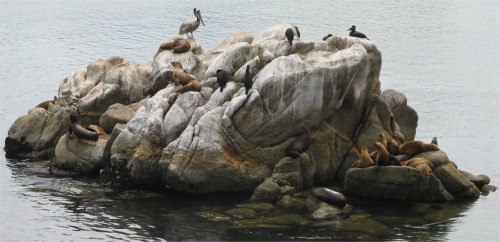
Pelican, Cormorants and Seals in Harmony on the Rocks
|
Once I had cleared the internet out of the way, I set about exploring a bit more of Monterey. The navigator Sebastian Vizcaino landed here in 1602, and named the bay after his patron, the Count of Monterey. But it was not until the Spanish captain Gaspar de Portola and Father Serra arrived in 1770, establishing a church and presidio, when Monterey grew into a pueblo. It served as the Spanish Colonial capital of California until the gold rush of 1848, when it lost its status to San Francisco.
The town still retained its unique character as a fishing port and market town, and had gone to great lengths to preserve its historic buildings, making it the most historic town in California.
I ambled down to the maritime museum, but unfortunately it was shut until next year. I passed Fisherman's Wharf again. In the 1800s, this was the epicentre of Monterey's fishing and whaling industries, but was now better known for its restaurants. Around the wharf, the seals were still dominating the scene on the water, but were harmoniously sharing the rocks with a pelican and cormorants. I hadn't seen any sea otters yet. They were usually found in or around the kelp forests, dining on invertebrates such as crabs and octopi, often using small rocks to crack open hard-shelled prey. Lacking blubber, they burned calories quickly and had to eat up to 25% of their body weight each day. To keep their thick fur waterproof, they would spend hours grooming. Humans had up to 100,000 hairs on their entire head, well not in my case. An otter would have up to a million hairs per square inch, the densest fur of any mammal. The otters were hunted almost to extinction in the 1700s and 1800s, and their population had grown slowly over the years. However, they were still susceptible to oil spills, pollution and disease. They were canny wee creatures too, they often slept side-by-side wrapped up in kelp so that they wouldn't drift away.
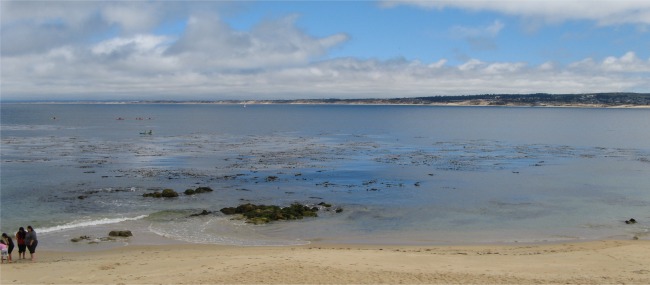
Monterey Bay and Kelp Forest with a Rare Hint of Blue Sky. Kelp can Grow 10" per Day!
|
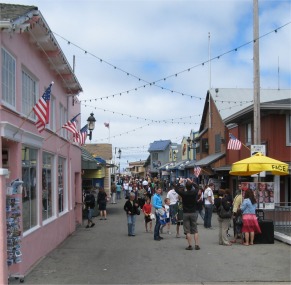
Fisherman's Wharf
|
Walking in an westerly direction brought me to Cannery Row. At the turn of the 20th century, this six-block seafront part of Monterey was where more than twenty fish processing companies canned fish fresh, particularly sardines, off the boats. The canneries thrived in the early 20th century, particularly after World War I when the plants became mechanised. However, in 1945, the sardines disappeared, and consequently the canneries were abandoned. The remaining buildings now housed a collection of fine restaurants, galleries, and shops. Above the roadway, covered ways once contained conveyor belts that shipped the tinned sardines from the processing plants built out over the water to the shipping warehouses on the inland side of the road.
Some said that Cannery Row was the visitors most popular destination. John Steinbeck loved the area, and spent some time here. In fact he wrote two books,
Cannery Row and
Sweet Thursday, set in and around this industrial Mecca.
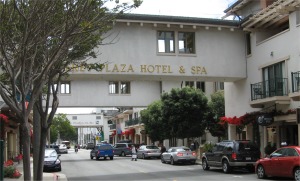
The Hotel End of the Canneries
|
|
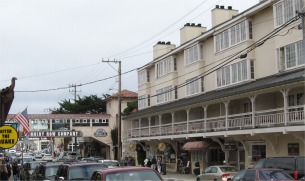
The Tourist End of the Canneries
|
|
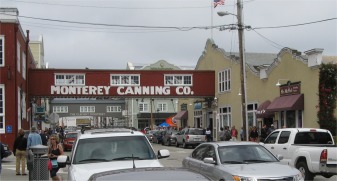
Even More of the Canneries
|
|
At the far end of Cannery Row was the world-renowned Monterey Bay Aquarium, a must-see attraction. However, when I saw the queue, I decided not to see.
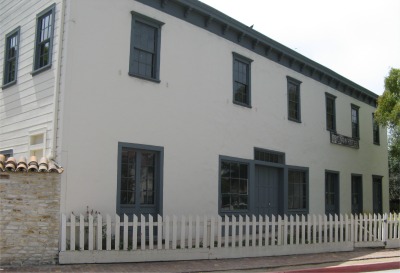
Robert Louis Stevenson's House Where He Lived in 1879
|
From Cannery Row, I sought out the house where Robert Louis Stevenson lived in 1879. Stevenson was inspired by the wonders of the peninsula's forest and sea. The building was still standing, and was now a museum, sadly only open at weekends. The notorious golf course on the peninsula, designed by Robert Trent Jones, Sr., was given a name from the classic tale
Treasure Island, Spyglass Hill Golf Course.
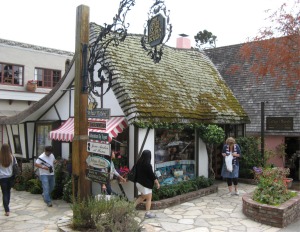
Typical Carmel Shop
|
By now, I felt I had seen enough of Monterey, and decided to head a couple of miles down the coast to Carmel. The 1x1 square mile wealthy resort was once a haven for the bohemian artist set, and even today attracted celebrities such as Clint Eastwood, who served as mayor from 1986-1990. The charming village contained a central plaza area that was bustling with boutique shops, jewelry shops, and 100+ art galleries, quite a few of which I visited. It was throbbing with tourists, all it was all very twee. For me if was a little too "chocolate box cover". I chatted to one gallery owner who agreed with my sentiments about the "chocolate box" effect. The former artist's colony was struggling with high rents, and many artists were deserting the village. This seemed to be a cyclic event.
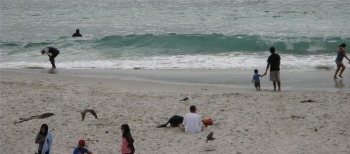
Carmel Beach
|
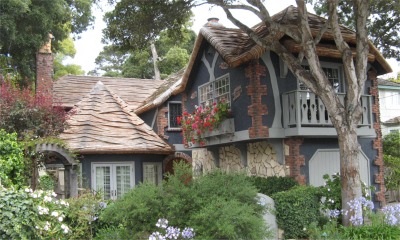
"Windamere" in Carmel
All Houses Must Have Names, Numbers Were Not Permitted
|
The beach was spectacular, a superb stretch of white sands, with blue translucent waves gently rolling over onto them. The occasional hint of sunshine made it all sparkle and quite magical.
There was a singular uniqueness about this beach. When I was at Lake Powell and Lake Mead, folk tended to stake out their piece of beach with towels, chairs, bags, parasols and other such paraphernalia, just as they do in any other part of the world. Here, there were no such territorial claims, people were happy to stroll down to the beach, walk along it, have a paddle, and so on. Perhaps the primary aim of their visit to Carmel was to browse around the plaza and spend a few dollars, with the beach being a poor second transient stop off point.
I decided to eat in Carmel tonight, just to be up market.










